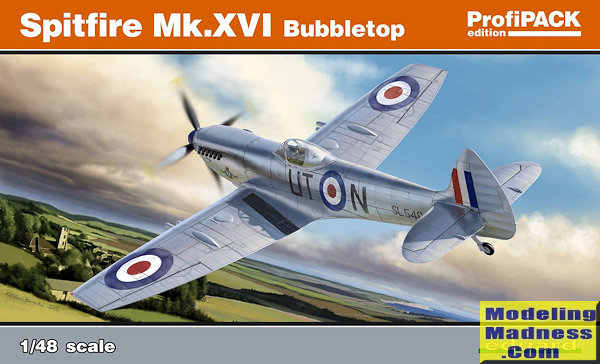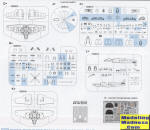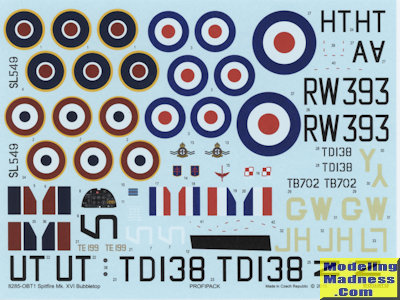
| KIT #: | 8285 |
| PRICE: | $49.95 SRP |
| DECALS: | Five options |
| REVIEWER: | Scott Van Aken |
| NOTES: | Profipack |

| HISTORY |
The Mk XVI was the same as the Mk IX in nearly all respects except for the engine, a Merlin 266. The Merlin 266 was the Merlin 66 and was built under license in the USA by the Packard Motor Company. The "2" was added as a prefix in order to avoid confusion with the engines, as they required different tooling. All Mk XVI aircraft produced were of the Low-Altitude Fighter (LF) variety. This was not determined by the length of the wings (clipped wings were fitted to most LF Spitfires), but by the engine, which had been optimised for low-altitude operation. All production Mk XVIs had clipped wings for low altitude work and were fitted with the rear fuselage fuel tanks with a combined capacity of 75 gal. Many XVIs featured cut-down rear fuselages with bubble canopies. On these aircraft the rear fuselage tank capacity was limited to 66 gal.
Because of a slightly taller intercooler and rearranged accessories on the Packard Merlins a new, bulged upper cowling was introduced and also appeared on late production IXs.
Armament for most Mk XVIs consisted of 2 × 20 mm Hispano II cannon - each with 120 rpg - and 2 × .50 calibre Browning machine guns - each with 250 rpg. 1 × 500 lb (227 kg) bomb could be carried underneath the centre rack, and 1 × 250 lb (114 kg) bomb could be slung under each wing. Some production aircraft had rear fuselage fuel tanks in addition to the main tank which allowed it to fly approximately as far as the Spitfire Mk VIII. Problems with the licence-built engines limited introduction to front-line squadrons for several months. A total of 1,054 Mk XVIs were built by Castle Bromwich.
| THE KIT |
 Eduard
has earned a reputation for its Spitfires and when you open the box you can see
why this is the case. The molding is superb and unlike some of their other kits,
this one does not have a plethora of open hatches. In fact, aside from the
ability to slide back the canopy and leave the cockpit access door open, there
are not any other bits that can be left open.
Eduard
has earned a reputation for its Spitfires and when you open the box you can see
why this is the case. The molding is superb and unlike some of their other kits,
this one does not have a plethora of open hatches. In fact, aside from the
ability to slide back the canopy and leave the cockpit access door open, there
are not any other bits that can be left open.
The kit provides a couple of different wings with one pair being the original and the other having the additional fairing to clear the wider tire. This latter one is used on both the post war silver options. Also part of the post war options are three spoke wheels vice four.
One finds a nicely detailed cockpit and thanks to the photo
etch fret, you have a colored instrument panel, armor plating and a number of
other embellishments. Speaking of armor plating, there are two aft cockpit
bulkheads provided, one which will not use the photo etch armor plating .
In this light, if one wishes to use the standard plastic instrument panel with a
decal, that is available as well, though I'm not sure why you'd want to go that
route as the p.e. version is so much nicer.
.
In this light, if one wishes to use the standard plastic instrument panel with a
decal, that is available as well, though I'm not sure why you'd want to go that
route as the p.e. version is so much nicer.
As I mentioned you get two wing options. There are rounded tips, but those are not appropriate for this variant. The wheel wells build up from straight sections. The kit provides multiple tail planes and elevators, but again, only some of those are germane to the Mk. XVI. Two styles of exhaust are provided, one circular and the other flattened on the exit. No indication of which is used on which option is provided, but they are very nicely done. In addition to the separate elevators, the rudder and ailerons are also separate. No separate flaps on this one, as the Spitfire was never parked with them lowered as they blocked radiator air flow. The radiator exhaust exit doors can also be posed open. Some of the post war options had stubs in place of the gun barrels and these will need to be modified from the kit bits. There are a pair of bomb racks and bombs provided. These are probably more for the wartime options as post war, these sorts of things were generally removed.
 Instructions
are superb and provide insight as to what bits are used with which markings
option. I found the markings options to be a bit dull, but perhaps that is the
norm for this version. Two are in overall silver; one is the box art plane from
17 Squadron in 1950, while the other is a racer from 601 Squadron in 1949 with a
red fuselage band and racing numbers. The other three are in standard wartime
camo. One is with 317 Squadron in 1946 decked out in special markings for a
display at Warsaw that never happened thanks to Soviet interference. One with no
codes and yellow wing tips is from 21 Group in 1948 and the third has French
roundels with 340 Squadron in May 1945. The decals are very nicely done and a
separate sheet not shown provides full stencils. Also included is a set of
canopy masks.
Instructions
are superb and provide insight as to what bits are used with which markings
option. I found the markings options to be a bit dull, but perhaps that is the
norm for this version. Two are in overall silver; one is the box art plane from
17 Squadron in 1950, while the other is a racer from 601 Squadron in 1949 with a
red fuselage band and racing numbers. The other three are in standard wartime
camo. One is with 317 Squadron in 1946 decked out in special markings for a
display at Warsaw that never happened thanks to Soviet interference. One with no
codes and yellow wing tips is from 21 Group in 1948 and the third has French
roundels with 340 Squadron in May 1945. The decals are very nicely done and a
separate sheet not shown provides full stencils. Also included is a set of
canopy masks.
| CONCLUSIONS |
This is a very nice kit and one that should build fairly nicely and without too much fuss. Now is the Profipack version worth $20.00 more than the weekend edition? It seems that the WE does not include the seat back armor plating, though the head plating is there. You have to ask if a color p.e. fret, three additional markings options, and a set of canopy masks is worth the premium price.
| REFERENCES |
https://en.wikipedia.org/wiki/Supermarine_Spitfire
April 2016 Thanks to me for the preview kit. If you would like your product reviewed fairly and fairly quickly, please
contact the editor
or see other details in the
Note to
Contributors.